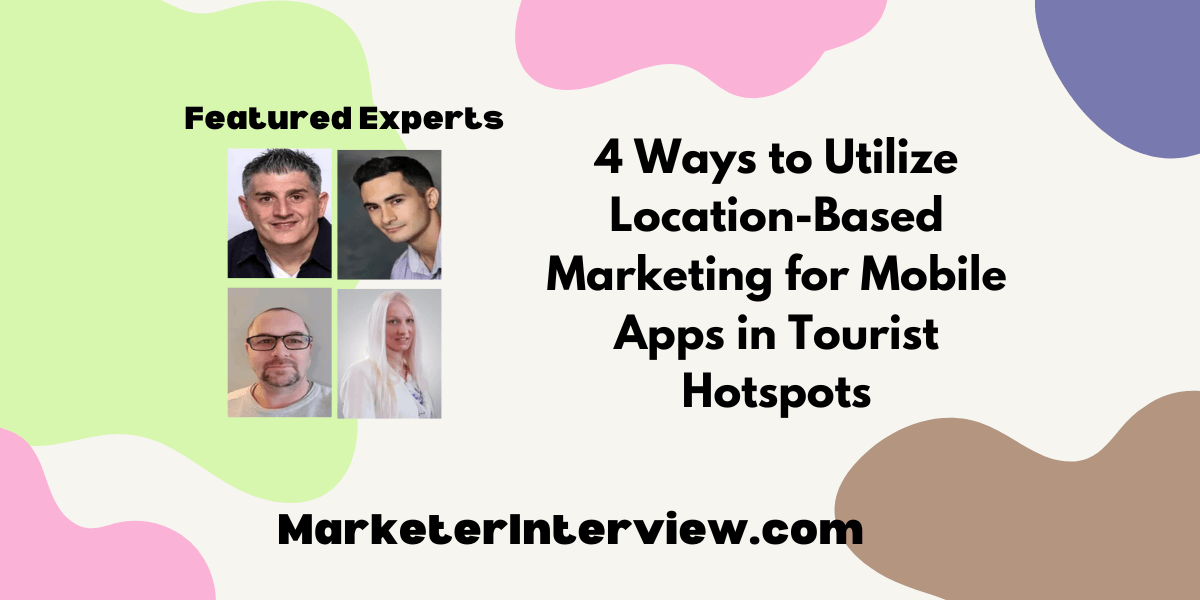4 Ways to Utilize Location-Based Marketing for Mobile Apps in Tourist Hotspots
Discovering innovative strategies for location-based marketing in tourist hotspots can be a game-changer for mobile apps. We’ve gathered insights from a Marketing Manager and a CEO, among others, to bring you four specific methods. From utilizing geofencing for personalized deals to enhancing exploration with interactive maps, learn how to effectively engage your mobile audience.
Want to get quoted in MarketerInterview.com content just like this? Apply to become a contributor today!
Contents
Utilize Geofencing for Personalized Deals
I remember visiting Rome a few years ago and being amazed by how many apps suddenly popped up on my phone, offering me deals on local restaurants, guided tours of historic sites, and even discounts on souvenirs. It made exploring the city so much easier and more enjoyable!
One specific approach that stood out to me was the use of geofencing. As I wandered through different neighborhoods, my phone would buzz with notifications about nearby attractions, restaurants, or shops. It felt like having a personal tour guide in my pocket, leading me to hidden gems I might have otherwise missed. I even received a discount code for a gelato shop as I passed by, which was a delightful surprise on a hot summer day.
These location-based notifications weren’t just convenient; they were also incredibly relevant to my interests. I later discovered that the app I was using had cleverly tracked my previous searches and preferences, tailoring its recommendations based on my individual tastes. It was a brilliant example of how location-based marketing can be used to create a personalized and engaging experience for tourists.

Liga Rudzite, Marketing Manager, Lemon Pitch
Tailor Content with User Location Data
At our company, we’ve capitalized on using location-based marketing through personalized mobile app content. This involves using data gathered from the user’s location and previous interactions with the app to tailor the content they see. For example, if a user frequently visits museums, the app can recommend new museum openings or exclusive art exhibits nearby. To make this work, sophisticated algorithms analyze user behavior and location data to predict and suggest relevant activities. This personalization makes the app more engaging, as users receive content that feels specifically curated for their interests and current location. Additionally, this strategy encourages longer app usage and deeper interaction, as personalized content is typically more compelling than generic information.

Jason Hennessey, CEO, Hennessey Digital
Engage Tourists with Beacon Technology
Beacons are small, wireless devices that use Bluetooth technology to transmit signals and communicate with nearby mobile devices. This technology has become increasingly popular in location-based marketing, especially in tourist hotspots. By placing beacons strategically around these areas, app developers can send targeted notifications and advertisements to users who are within range.
For example, a user walking past a restaurant or attraction could receive a notification with a discount offer or information about the location. This creates a more personalized and interactive experience for tourists, potentially increasing their engagement with the app and boosting sales for businesses in the area.
By using beacon data, developers can gather valuable insights on user behavior and preferences, allowing them to further tailor their marketing strategies for maximum impact. This method not only benefits app developers but also local businesses and tourists alike. So, incorporating beacon technology into mobile apps is a great way to utilize location-based marketing in tourist hotspots.

Alex Capozzolo, Co-Founder, Brotherly Love Real Estate
Enhance Exploration with Interactive Maps
Creating interactive maps and guides as part of location-based marketing for mobile apps in tourist hotspots offers several compelling benefits. Firstly, interactive maps provide users with real-time navigation and orientation, helping them easily explore unfamiliar destinations with confidence. By integrating features such as GPS tracking, points of interest (POIs), and customizable routes, these maps enhance user convenience and satisfaction, ensuring a seamless travel experience.
Secondly, interactive guides within the app can offer rich, contextual information about nearby attractions, historical sites, restaurants, and events. This content can be personalized based on the user’s location and preferences, providing relevant recommendations and insights tailored to their interests. For instance, apps can highlight hidden gems, local favorites, or seasonal activities, enriching the user’s exploration and encouraging longer engagement with the app. Moreover, these interactive features foster deeper engagement and loyalty as users rely on the app for comprehensive, up-to-date information and navigation assistance throughout their journey.
So, by enhancing user experience and delivering valuable content in real-time, interactive maps and guides empower mobile apps to become indispensable tools for tourists, driving increased usage and positive word-of-mouth recommendations.

Wayne Mills, Head of Operations, Seven Seas Worldwide
Want to get quoted in MarketerInterview.com content just like this? Apply to become a contributor today!






